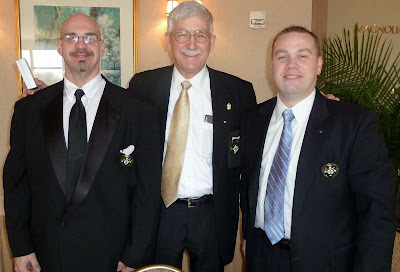The New Jersey Second Circle of The Masonic Society will host its Saint John’s Day Feast on Friday, June 24 in North Brunswick, New Jersey.
An evening of good company, good conversation, and good food, with the added attraction of a very special guest speaker, awaits you.
In honor of St. John’s Day, we will welcome to our podium the Director of the Center for Middle Eastern Studies at Rutgers University, who will tell us about a fascinating gnostic religion that dates back to antiquity, yet still survives today.
Dr. Charles Haberl’s topic is the Mandaean faith, a tiny Abrahamic religion that upholds John the Baptist as its ultimate teacher. This religion exists in and around Iraq, but is almost on the verge of extinction. What he has to say about the Baptist in particular should intrigue every Freemason, and the plight they suffer today makes Dr. Haberl’s presentation even more compelling.
Dr. Haberl also is an Assistant Professor at the Department of African, Middle Eastern, and South Asian Languages and Literatures at Rutgers. He has served as an Undergraduate Fulbright Faculty Advisor and as a member of the Advisory Committee for Study Abroad Programs in the Middle East at Rutgers, as well as a juror and panelist for the United States Department of State’s Critical Language Scholarships for Intensive Summer Institutes. With James McGrath of Butler University, he received an NEH grant to translate the Mandaean Book of John in 2010. We are very fortunate to have him.
$50 per person. Reservations are required and can be made ONLY by sending your payment, via PayPal, to: masonicrsvp@gmail.com no later than Monday, June 20.
Great food: Unlimited hot hors d'oeuvres (served butler style), your choice of entree is Baked Stuffed Chicken or Roast Top Sirloin of Beef or Broiled Stuffed Filet of Flounder. Plus side dishes, salad, desserts with coffee etc., and unlimited soft drinks. (Cash bar only.)
NAME YOUR ENTREE when you transmit your payment.
It is NOT necessary to be a member of The Masonic Society to attend this special event. ALL Masons, their ladies, and friends are welcome to this fraternal and spiritual celebration of one of the Patrons of the Craft. Remember it was on June 24, 1717 when the Grand Lodge of England was formed, ushering in the age of modern Freemasonry as we know it.
Seating is limited, so no walk-ins can be accommodated. No reservations can be honored without advance payment via PayPal.




















































































